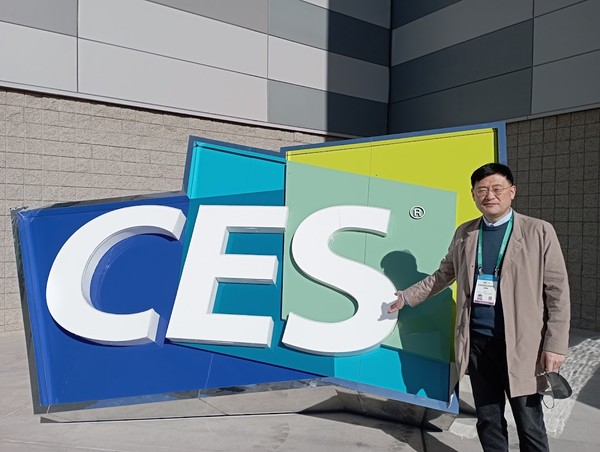Min Kyeong-joong, director of KBR Meta-Health Lab
It’s already been nearly a decade since I began to attend the International Consumer Electronics Show (CES) in Las Vegas, Nev. However, it was more than three decades ago that I first got interested in the annual gathering of global appliance makers and their cutting-edge products.
CES, which made its debut in 1967, will greet its 56th anniversary from Jan. 5-8 next year.

It is now called one of the best exhibitions worldwide. However, it wasn’t like that from the beginning. From the 1980s to the mid-2000s, the absolute dominator in the IT sector was COMDEX (Computer Dealers Exposition) show held every spring and autumn.
In 1988 when I entered a media company and covered the Seoul Olympics, even desk computers were rare. So when I ran around the scenes of coverage as a cub reporter, I was fascinated to see foreign journalists write articles with something like a "small typewriter." It was even more interesting to see them insert a phone line into a small hole on the side of the device after writing the article and send it somewhere.
When Korean journalists wrote an article at the time, they grabbed a phone and read out the story to desk reporters called "catchers." Carphone, which started service in 1988, was pie in the sky.
It was in 1992 that Korea Telecom began to provide the HiTel terminal, a comprehensive internet service network, for media companies. All press rooms could install faxes perfectly a few years later.
In those days, Korean journalists saw their foreign counterparts send articles to their headquarters using Toshiba’s T110 laptop and telephone modems with awe. Among Korean media companies, the Yonhap News Agency was the “most advanced,” sending articles using large desktop computers at each stadium.
After the Seoul Olympics, on a business trip to Japan, the world's strongest electronic powerhouse then, I bought a Toshiba Dynabook by investing three months’ salaries. When most other Korean journalists wrote articles on manuscript papers, I used a laptop computer for the first time in the nation, drawing attention and appearing as a regular on the TV news wallpaper.
Since then, I have purchased as many as 18 laptops directly at home and abroad or through acquaintances whenever a new model came out.
My bank account balance was always negative, but I earned the endearing nickname of “early adapter in the media” by using the internet and covering the information and communication field since the mid-1990s. So naturally, the COMDEX and CES were the subjects of my attention, and it was my dream to participate in them in person.
And since the early 2010s, I've realized my dream of participating in CES almost every year, attained some know-how, and shared such information through lectures, SNS, and blogs.
In 2020 when Covid-19 had just begun, I attended the CES, but the event was held online last year. As the CES 2022 resumed its exposition offline, it served as an occasion to make us realize the importance of face-to-face gatherings among people. Even the Omicron variant could not smother our thirst for direct encounters.
The Omicron wave was horrible, forcing IT giants like Amazon, Meta Platform (formerly Facebook), Twitter, and Pinterest to declare their absence. However, what's scarier than the disease for entrepreneurs is the failure to showcase their products or technologies developed with sweat and tears.
In particular, Korean SMEs and startups boldly participated in the show, braving the "risk." While China, which traditionally ranked second in the size of participation, was absent, considering quarantine problems and the strained relationship with the U.S., Korean businesses ranked second after the U.S. companies in size. That enabled the K-Tech to shine before global buyers and media outlets, which was as touching as BTS songs that frequently resonated throughout Las Vegas.
CES2023 is about two months away. I stress the need to participate in CES in front of businesspeople, journalists, and even students in my class. Not long ago, I gave a lecture to senior school members in their 70s. The theme was “The CES you must go and see before dying.”
Usually, the themes of such lectures were "How you can live a healthy life" or "What a happy life is.” However, it was about the future this year, asking, “how the world will change in 2050, which is 27 years away?
I told them as follows;
“You are already entering the centenarian age. Until when will you live only by hiking or walking around the neighborhood? You will have a chance to travel in space within the next 10 years. Ask your sons or daughters-in-law to “send you to CES in Las Vegas.”
CES's history and future story must have attracted great interest from the 70-something audience. After the lecture, the person who organized it sent a message.
"The response from senior school students was explosive. They thanked you more than ever for telling them about the changes in the future society. They said they had come to have a dream of going to the CES before they died.”
Again, I'd like to say CES is the biggest show on earth that anyone of all ages must go and see.
The writer is the director of KBR Meta-Health Lab. He is also a visiting professor at Hankuk University of Foreign Studies and a director at JP Law Firm. – Ed.

